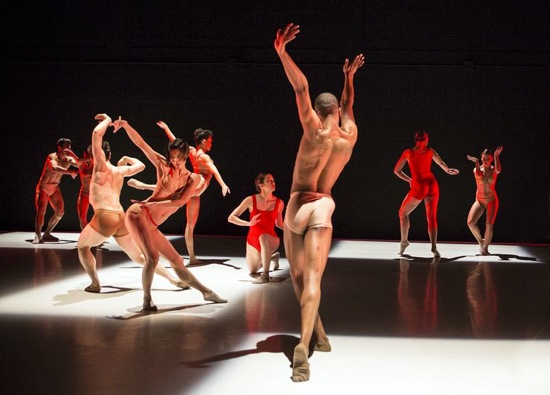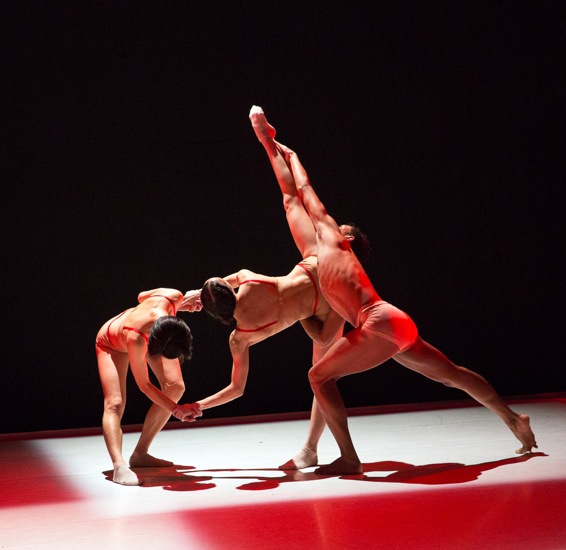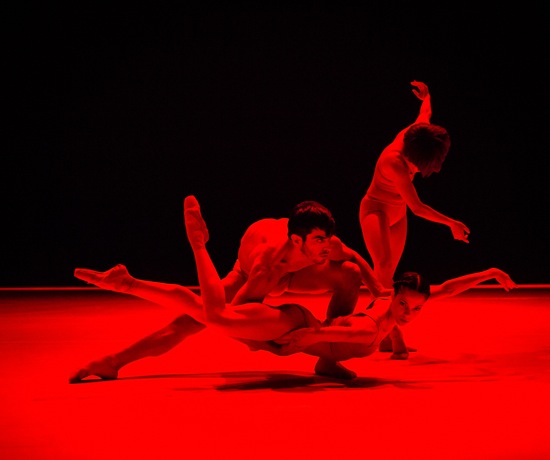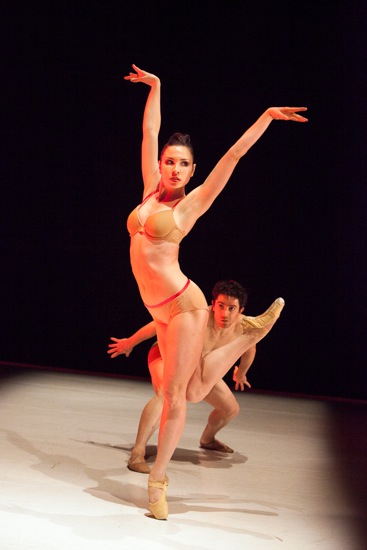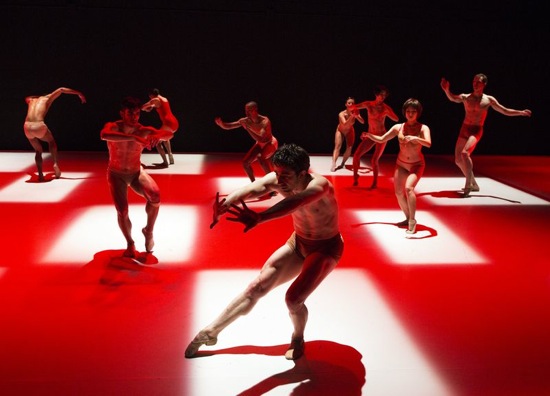
Members of Armitage Gone! Dance in Mechanics of a Dance Machine; foreground: Cristian Laverde König. Photo: Yi-Chun Wu
When I look closely at a broccoli floret, I don’t ponder fractal geometry; I may marvel at images derived from Fibonacci sequences, but I don’t pretend to understand Walsh functions. Choreographer Karole Armitage might consider me an intellectual wimp. Her Three Theories premiered in 2010 at the World Science Festival.
Although Armitage’s new Mechanics of the Dance Machine at New York Live Arts (1/31-2/2 and 2/7-9) attests to her ongoing fascination with physics, you don’t need to see her sources reflected in the choreography in order to be intrigued by the patterns she devises. This isn’t one of those occasions when you read an ambitious program note and then look at the dance it purports to elucidate and say, “huh?”
What you see onstage (and, because of a schedule screw-up, I saw the piece at its final dress rehearsal) has a logic whose presence you deduce. Like Merce Cunningham, in whose company Armitage danced for a number of years, she often presents the space as an open field in which various events occur simultaneously or succeed one another or pass through. You don’t question why the dancers are doing what they’re doing. On the other hand, she performed in a number of Balanchine’s ballets during her young days dancing with the Grand Ballet de Génève, and her present style can be considered as a juiced-up descendant of Balanchine’s approach to scores by Stravinsky or Hindemith.
The apparent irregularity of choreographic patterns and encounters in Mechanics of the Dance Machine plays against and within Clifton Taylor’s extraordinary collaborative lighting design. His palette is heavy on reds. At times the white floor becomes a checkerboard of red and white squares, but the size and number of squares may vary, or appear in the more conventional black and white. He also creates aisles of light, or makes the front half of the area bright and the back dark, or turns the whole floor red.
Mechanics is set to Gabriel Prokofiev’s Concerto For Turntables And Orchestra, performed in a recording by DJ Yoda & the Heritage Orchestra. The remixes include works by Monster Bobby, Kreepa, and Medasyn; an exerpt from J.S. Bach’s Keyboard Concerto No.1 in D Minor sneaks in as a tuneful surprise. Craig Leon’s “Four Eyes to See the Afterlife” from the album Nommos also figures in the dance.
Through this visual-aural landscape prowl eight members of Armitage Gone! Dance, two guest artists (Charles Askegard and Cristian Laverde König), and five women who are part of the company’s Professional Project. The men wear light-brown briefs and the women even briefer panties and bras edged in red, with a few red dresses worn by the Professional Project dancers (costumes by Alba Clemente and Deanna Berg MacLean). I say “prowl” because the dancers often move like animals out hunting—sleek, hot, hungry, and calculatingly skillful. The principal women are sometimes on pointe, sometimes in flesh colored socks, and little that they do looks “beautiful” in a balletic way. The adept cast members throw their legs around in precise abandon— perhaps swinging one leg to the side or back and then pulling it around to the front and beyond, bending forward as they do so (the butt presentation is a frequent occurrence). When two or more dancers meet, they form unusual, sometimes bizarre, interlocking designs. The effect is fiercely sensual, but without lasting dramatic intent.
The beginning sets the hot-cool ambiance. The splendid Megumi Eda makes an appearance downstage right. A short distance away, Abby Roesner is preoccupied with her own preening dance. Beyond them, two couples—Lourdes Rodriguez and Jeffrey Sousa, Ahmaud Culver and Masayo Yamaguchi—engage in different intimate pursuits, the women on pointe. One memorable image: Sousa cradles Rodriguez in front of him; she’s lying on her belly in his arms in a ballet-swan position that rightfully would be seen flying overhead. He lowers her to the floor without breaking her line, looking as if he’s considering eating her, daring anyone to take her from him.
Clearly this tribe values aggressive heterosexuality. König watches Roesner from a crouched, hunched posture before closing in on her. Sousa whispers in Yamaguchi’s ear—perhaps challenging her to their ensuing combative duet. The five women from the Professional Project sit along the rim of the area of light where Askegard bends Emily Wagner to his will, looking somewhat courtly, even though he has to rub his leg up her thigh; the watching women shift into various aggressive postures like grounded predatory birds awaiting the outcome. (The second week of Armitage Gone! Dance, König replaces Askegard, who’s performing up the street at the Joyce with Jacqulyn Buglisi’s company.)
Eda epitomizes the Armitage dancer. In her various appearances in this piece, including in a meaty solo, she displays her lithe, leggy beauty. She uses her long body as a snake would, sliding it into surprising angles and curves. A brilliant performer, she has been a vital part of Armitage Gone! Dance for ten years. This season marks her last with the company. Our loss.
It’s difficult to convey in words the complexity and variety of Armitage’s choreography for this work. The patterns form, accumulate, dissolve—sometimes visible only briefly. You occasionally sense a build in terms of ebb and flow, but Mechanics of the Dance Machine doesn’t work toward a climax. If you take “mechanics” to refer to the dancers rather than to a process, then you could say that they’re constantly tinkering with the machine’s parts—fitting this to that, disconnecting something else, trying out new supplies in various combinations. But their demeanor is anything but workmanlike. Each coupling, each linkage, has the intensity of an erotic encounter, with us as fascinated voyeurs.

